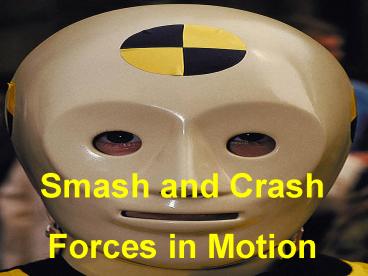Smash and Crash - PowerPoint PPT Presentation
1 / 24
Title:
Smash and Crash
Description:
Force is a function of mass X acceleration. Different shapes are ... this prototype of a container to hold quail eggs safely for a trip to the Space Station. ... – PowerPoint PPT presentation
Number of Views:35
Avg rating:3.0/5.0
Title: Smash and Crash
1
Smash and Crash Forces in Motion
2
- So far we have been learning about force and how
force affects different shapes. - Lets review
- Force travels in a straight line. This line may
be very, very short - Force is a function of mass X acceleration
- Different shapes are affected by force
differently. - Force travels through a structure along its
axis. When it encounters a joint, it changes
direction. It may split, too.
3
(No Transcript)
4
We have also leaned in the Mat challenge to find
the focus the central element that is most
important for our goal. We also realize that our
concept or idea of what we are doing affects our
solutions. What is the focus of the Mission to
Mars?
Write this in a statement that will fit on a T
shirt!
5
(No Transcript)
6
(No Transcript)
7
The goal of our mission is to deliver a live
chicken to mars. Which means So lets take
a look at some examples of vehicles designed to
survive a crash. http//www.youtube.com/watch?vw
7Q4lAWzL3wfeaturerelated
8
As we look at these examples of compact cars
crashing, we notice the funny things that force
does to a structure. Wheels pop off, which also
explains why a whip cracks as it passes the
energy through itself to the tip. The energy
explosion is the force left over! Vehicles spin
around the opposite side of the energy and there
are lots of pieces in the road. But what
essential elements are not affected, or rather,
what elements are not supposed to be affected?
9
Lets take a look at how the Smart Car handles
force.
10
It turns out that we can not alter the physics of
the problem in any meaningful way. The mass will
remain the same, the velocity is the same but
what we can do is alter the time it takes for the
force to impact the vehicle. We do this by
trading distance for time but only up to a point.
Crumple zones bleed off energy by slowing down
the force. The cage surrounding the passengers
transfers the force to the rear and around the
occupant.
11
Meanwhile, simultaneously and at the same time,
the soft target is protected by air bags that
uses time to alter distance. This is the opposite
strategy used in the exterior.
Unfortunately, we do not have air bags or smart
cars to go to Mars!
12
(No Transcript)
13
Spherical shapes move force around the exterior.
A hard shell transfers force along the multiple
axis, (360 degrees if your structure is
symmetrical).
14
(No Transcript)
15
(No Transcript)
16
Inside, we need to build a cage around the
passenger and then provide a way to slow down the
forces by trading distance for time. What would
happen if the interior were rigid using Newtons
1st Law of Motion.
17
(No Transcript)
18
Hard shell covers a soft inside But what is in
between?
19
NASA spent almost 78,000 for this prototype of a
container to hold quail eggs safely for a trip to
the Space Station. But would the eggs survive a
crash landing on a planet?
20
Directed force We can not change the mass nor
can we change the force but we can control where
the force impacts our structure.
21
How do we do this? Dynamic shape Dynamic
mass Dynamic structure But what does this look
like?
Thats your problem!
22
Whats Your Solution?
- Write a goal statement that demonstrates your
understanding of the challenge. This concise
statement will describe the focus of the project. - Make a full size sketch of your proposed solution
to the Mission to Mars challenge. - Show where the egg will be positioned and
provide details of how you will cradle it. - Use arrows to show how you plan to deal with
the force of impact on the shell and the cradle.
23
Whats Your Solution?
- When your sketch is complete, review your
proposed solution with your instructor before you
receive your egg.
24
(No Transcript)































